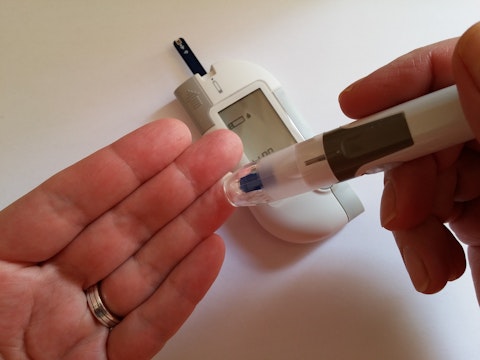Renalytix Plc (NASDAQ:RNLX) Q4 2023 Earnings Call Transcript September 29, 2023
Operator: Good morning, and welcome to the Renalytix Conference Call to Review Fourth Quarter and Full-Year Fiscal 2023 Financial Results. At this time, all participants are in a listen-only mode. We will be facilitating a question-and-answer session towards the end of today’s call. As a reminder, this call is being recorded for replay purposes. I would now like to turn the call over to Peter DeNardo of CapComm Partners for a few introductory comments. Please go ahead.
Peter DeNardo: Thank you, Michelle, and thank you all for participating in today’s call. Joining me today from Renalytix to provide formal remarks are James McCullough, Chief Executive Officer; Tom McLain, President; and James Sterling, Chief Financial Officer. Before we begin, I’d like to remind you that management will make statements during this call that include forward-looking statements within the meaning of the Private Securities Litigation Reform Act of 1995. Any statements made during this call that relate to expectations or predictions of future results and events or performance are forward-looking statements. Examples of these statements include, without limitation, the potential benefits, including economic savings of KidneyIntelX, the commercial prospects of KidneyIntelX, including whether KidneyIntelX will be successfully adopted by physicians and distributed and marketed, our expectations regarding reimbursement decisions and the ability of KidneyIntelX to curtail costs of chronic and end-stage kidney disease, optimize care delivery and improve patient outcomes, trends in our market and potential benefits of government policy change, the impact of COVID-19 and other world events on our business, our expectations for hiring, product development, strategic partnerships and collaborations, reimbursement decisions, clinical studies and regulatory submissions, our business strategies and future growth, including plans, expectations and opportunities for financing operations and revenue projections and guidance.

Pixabay/Public Domain
These statements involve material risks and uncertainties that could cause actual results or events to materially differ from those anticipated or implied by these forward-looking statements. Accordingly, you should not place undue reliance on these statements. For a description of the risks and uncertainties associated with our business, please refer to the Risk Factors section of our annual report on Form 10-K that was filed today, September 28, 2023, with the Securities and Exchange Commission. All forward-looking statements made on this call are based on management’s current estimates and various assumptions. Renalytix disclaims any intention or obligation, except as required by law, to update or revise any financial projections or forward-looking statements, whether because of new information, future events or otherwise.
This conference call contains time-sensitive information and is accurate only as of the live broadcast today, September 28, 2023. I’ll now turn the call over to James McCullough. James?
James McCullough: Thank you, Peter. Good morning, good afternoon. In short order, around this quarterly period, we crossed major thresholds and reimbursement outcomes data and achieved an FDA de novo marketing authorization for KidneyIntelX. Our progress was further amplified by inclusion of KidneyIntelX in the draft leading kidney care guidelines, KDIGO, for 2023. It is rare to see all of these milestones passed sequentially, measured in months. And we believe that these are significant for the broader adoption and clinical acceptance of KidneyIntelX for early prognosis of individuals with type 2 diabetes and early-stage kidney disease in the United States and abroad. On the growth equation, achieving these collective milestones now allows us to set the commercial target of a 1% United States market penetration over the next three years and our FDA authorized indicated use population of 14 million adults with diabetes and kidney disease.
We intend to do this through expanding hospital system partnerships, working closely with insurance companies covering KidneyIntelX and through our direct-to-physician sales force, whose expansion is continuing in specific areas in the United States under the new leadership of experienced sales executive, Howard Doran. In addition, the international opportunity with FDA in hand is also quite promising, particularly given the large growth in diabetes globally. As a reminder, we have been disciplined in maintaining a $950 price point or greater in our growing portfolio contracted insurance companies. This pricing was originally set by Medicare. Importantly, post FDA authority, we have reviewed our operating cost basis and are taking decisive actions to reduce our quarterly cash burn rate.
This reduction in cash burn should become most apparent in the second half of fiscal 2024 and is being undertaken without compromising our sales focus on growing testing volume and revenue. These reductions are on top of our net year-over-year OpEx reduction of $11 million. We will continue to look for opportunities to optimize cash expenditure and increase our cash position, particularly through non or less dilutive strategic partnering and potential international licensing opportunities. As far as we are aware, KidneyIntelX is now the only machine learning-enabled prognostic tool and chronic disease preventative medicine with an FDA authorization, established payment by a broad array of insurance companies, including Blue Cross Blue Shield groups, Medicare and Medicaid and real-world evidence demonstrating improved outcomes in both diabetes and kidney disease.
After a four-year FDA process, which included over one million patient calculations, three independent train test validate algorithm runs, we are proud KidneyIntelX has validated a novel pathway for artificial intelligence enabled in vitro diagnostic medicine. Several hard won regulatory innovations, including validation of a nonlinear machine learning algorithm, use of electronic medical record features, new predictive biomarkers and importantly, accurate and reliable prognosis from the earliest starting point in a chronic disease category, all provide KidneyIntelX with unique competitive positioning. Our view is these precedent solidified and a full regulatory process will be difficult to replicate without a considerable investment over a multiyear period.
In short, we are very pleased with our established long-term competitive advantages. As I noted earlier, we are pleased to have announced that senior executive Howard Doran has joined Renalytix to lead the global business effort, including U.S. direct-to-physician sales efforts. As of September, our direct-to-physician sales force is now active in several territories in the United States, in Texas, Florida, New York and North Carolina, all where the rates of diabetic kidney disease are high, where we have existing or anticipated hospital partners and where our insurance coverage, in many cases, exceeds 90% of the FDA-authorized indicated use population. We believe a number of pharmaceutical and medical device industry players would benefit from KidneyIntelX driven patient prognosis and supported care management in the diabetes market.
Recently, published data has shown that primary care physicians using KidneyIntelX are 4x more likely to prescribe GLP-1 agonists and SGLT2 inhibitors early on to diabetes patients at significant risk of kidney function decline. By identifying kidney care disease patients at risk early by using KidneyIntelX, the potential increase in new drug therapy use, particularly at the primary care level for pharmaceutical players is compelling. Ongoing publication of both our own and third-party KidneyIntelX outcomes and utility data are critical for establishing a new broadly used preventative standard of care. At Renalytix, we have invested heavily in real-world evidence generation since we began full operations in late 2018. As we presented in this quarter, KidneyIntelX outcomes data has exceeded our expectation by showing an association with clinical actions that in under 12 months led to observable changes in the core measure for diabetes health and kidney health.
Raising funds to fuel these clear commercial opportunities is essential, particularly now that we have reduced risks associated with the successful service product launch and adoption. To maximize our flexibility to fund business growth, we filed an S-3 shelf registration statement to give us the ability to source capital at the right time. Again, we will continue to explore less dilutive and nondilutive capital funding sources, particularly now that we have a unique product proposition post FDA authorization. I will now turn over to Tom McLain, our President, to discuss reimbursement activities and accomplishments during the period. Tom?
Thomas McLain: [Technical Difficulty]
James McCullough: It sounds like we’re having a communication with Tom – with your communication issue. I’ll go ahead and read Tom’s script for the moment. What Tom is going to say is following much hard work to accomplish the momentous task of achieving FDA authorization, we now believe that the KidneyIntelX deployment road ahead of us is wide open to accelerate test adoption. As James indicated, KidneyIntelX.dkd is now the only prognostic in vitro diagnostic test for assessment of chronic kidney disease progression with FDA authorization. Since we announced this at the end of June, our ability to engage in conversations with partners and payers has been elevated to a new exciting level. Following the announcement of FDA authorization, the Medicare administrative contractor responsible for test claim payment coming from our samples processed in our New York laboratory convened a Contractor Advisory Committee meeting, or CAC meeting.
A CAC meeting is recommended under the 21st Century Cures Act as part of the advancing the local coverage determination process. The purpose of the meeting was to discuss the clinical literature that supports advancing the development of a local coverage determination. There were a number of highly interactive discussions regarding the clinical utility of KidneyIntelX by independent physicians, selected by national government services. We were pleased with the outcome of the meeting and supported the dialogue by submitting a summary of how the evidence addresses questions posed to the CAC panel during the meeting. In summary, and especially following FDA authorization, we continue to be confident in our ability to secure a coverage determination from Medicare.
In keeping with our stated strategic goal of focusing our commercial efforts on regional areas where we can bring the benefits of our KidneyIntelX technology to large populations of adults, we recently announced expansion of insurance coverage in Texas. This was the result of executing a contract with Blue Cross and Blue Shield of Texas, the largest statewide health care plan covering seven million members in all 254 Texas counties. This organization works with more than 140,000 physicians and health care practitioners and 520 hospitals. Furthermore, we also executed an agreement for insurance coverage of KidneyIntelX with Parkland Community Health Plan, a Dallas-based insurance plan with over 300,000 covered lives and service in seven counties.
As a reminder, these regional agreements complement coverage already secured and announced previously, whereby Blue Cross Blue Shield plans cover our tests across millions of covered lives in Illinois, Maryland, Virginia, Iowa and South Dakota. It is unusual to achieve this level of comprehensive insurance reimbursement with such a short operating history. We expect our success with coverage will accelerate now that we have completed regulatory real-world evidence and clinical use milestones. Also, this level of insurance payment is an important validation of KidneyIntelX and a key component of the intrinsic value of the franchise for potential strategic partners. I would now like to turn the call over to James Sterling, who will discuss our financial results for the quarter and the year.
James?
James Sterling: Good morning. Today, we issued the financial results for our 2023 fiscal year, which ended June 30. Our GAAP financials were filed today on Form 10-K and will be followed shortly by our annual report under IFRS accounting. Figures I will discuss here are based on our GAAP financials and quoted in U.S. dollars, which is our reporting currency. We recorded total revenue of $3.4 million for fiscal year 2023, which was up about 15% over fiscal 2022. During fiscal 2023, we recognized services revenue of nearly $300,000 upon completion of two services contracts, including our projects with AstraZeneca. For the fourth quarter, we recorded revenue of $520,000 compared to $830,000 for the fourth quarter of the prior fiscal year.
As we noted on last quarter’s call, revenue has been impacted by the successful transition to commercial payment for testing at Mount Sinai. While total testing volume has remained relatively steady, certain clinical trial tests that were billable under the prior contract at Mount Sinai are no longer billable under the commercial model. Upon completion of study enrollment, we expect the percentage of billable tests to increase over the latter part of fiscal 2024. Operating expenses for the fourth quarter were $9.8 million on a GAAP basis, significantly reduced from $13.2 million for the prior year period. This reflects the result of the actions we previously took to lower operating expenses through program, vendor and employee reductions. Net loss for the fourth quarter of fiscal 2023 was $11.1 million or $0.11 per share.
This compared to a net loss of $5.2 million or $0.07 per share for the fourth quarter of fiscal 2022, which included a foreign currency gain of $5.1 million. Excluding the foreign currency gain, net loss for the year ago period would have been $10.2 million or $0.14 per share. We’ve continued to maintain a tight focus on controlling expenses. As a result, for the year ended June 30, net cash used in operating activities was about $33.4 million. This was down 27% from $45.9 million in the prior fiscal year. We ended the fourth quarter with approximately $24.7 million in cash as of June 30. And as James mentioned, we’re in the process of taking steps to further reduce our operating expenses to extend our cash runway. Operator, we can now please open the call for questions.
Operator: [Operator Instructions] The first question comes from Daniel Arias with Stifel. Your line is open.
See also 10 Best ASX Stocks To Invest In and 11 Best Battery Stocks To Buy Before They Take Off.
Q&A Session
Follow Renalytix Plc (NASDAQ:RNLX)
Follow Renalytix Plc (NASDAQ:RNLX)
Unidentified Analyst: Thanks for taking the question. It’s Paul on for Dan here. Just wondering about the sequential cadence looking forward into 2024 fiscal. So could you give some color on what you’re looking for in Q1 out of Q4 and from there, how does that play out through the year?
James McCullough: OJ, do you want to answer that?
James Sterling: Yes. That’s fine. And so we indicated in the RNS or the press release this morning that test volumes have stayed fairly consistent through the period and into this first quarter. Billable volumes – billable portion of that, just about half of our 1,200 or so quarterly testing volume. And do expect that to increase over the course of the fiscal year, both as a function of higher volumes as well as a higher percentage of billable testing among the tests that we do. Not giving specific guidance on a quarter-by-quarter basis yet at this time.
Unidentified Analyst: Sure. And then just for the follow-up, in terms of the Wake Forest EHR integration that you’re working on, did you see like a big inflection point in terms of how that cadence will roll out over the year? Or is that more of a – you can start scaling some volumes before that’s fully integrated, and it will be a little smoother?
James McCullough: So we’ve been working with Wake Forest for a while and things are going quite well. There are a lot of physicians using KidneyIntelX. At the moment, we’re switching that over to a commercial model later this year. The integration into a major system like Atrium, Wake Forest through Epic is a key proof point for us. We’ve already done that in Mount Sinai. Everybody is asking, okay, that’s great with Mount Sinai, let’s see it in another large system. Well, this is it. So Wake Forest Atrium is quite large, larger than Mount Sinai. And having KidneyIntelX fully integrated into Epic and available for many practicing physicians now to order online is going to be a key milestone for us and being able to do this with an independent Epic integration.
So we’re doing this directly in conjunction with Wake Forest IT Group. It’s been a tremendously successful process. We’ve learned an awful lot since we first did this with Mount Sinai. And it – I do very much believe in fiscal 2024, it’s going to start to produce evidence of increased testing use, and I’m very excited to see this system come online. I do believe that with a fully integrated KidneyIntelX in Epic, in a system like Atrium Wake Forest, you now open up the possibility for practice alerts to come out, especially now that we’ve passed through all of these significant milestones from outcomes data to utility data to FDA inclusion in the draft guidelines, expansive reimbursement. All of these milestones collectively add up to something that a large health care system can feel quite confident that KidneyIntelX should be part of standard of practice and should be something that should be broadly used across their primary care physician networks to be able to understand risk in diabetes and kidney disease and help mitigate outcomes and also cost.
So the Wake Forest Atrium deployment for us is a very high priority. And everyone should stay tuned, we’ll have more news on that coming up shortly.
Unidentified Analyst: Great. That’s helpful. Thank you. And congrats on all the progress.
James McCullough: Thank you.
Operator: Thank you. [Operator Instructions] The next question comes from Chris Glasper with Singer Capital Markets. Your line is open.
Christopher Glasper: Yes. Good morning, guys. Just a couple of questions, please. Firstly, can you just give us a little bit more color on the target penetration that you’ve outlined? I’m assuming that’s cumulative over three years? And then second question, really, just again, quantifying a little bit of detail around the further cost savings that you’re expecting to make? Thanks.
James McCullough: Yes, we’ll start with the cost savings. And then OJ, please comment on top of me. Market conditions are fabulous, as everybody knows, and market volatility is high. This is not an easy environment. So we’re taking cost reduction very seriously. We’ve already started to take specific steps so that we can lower our quarterly burn rate. We do not want to compromise our revenue-generating capacity. So it’s really a focus and a shift of priorities with a very heavy weight towards commercialization, which is good and appropriate at this stage of the company now that we’re on the other side of FDA. So we will continue to look for ways to narrow that burn rate. Obviously, other ways that you can narrow the burn rate is to increase the revenue.
And we’re working on that as well, specifically with the introduction of the direct-to-physician sales force. We talk about Atrium Wake Forest. There are other things in the pipeline that will give us additional exposure in select regions. So we’re really focused now in select regions where we have high rates of diabetes and high rates of kidney disease and high rates of insurance coverage for KidneyIntelX. So these are optimal areas for us to expand and grow now. So it’s really a focusing of the company at the right time at the right place, and we’ll continue to look for ways to optimize cash use as we go forward. But obviously, we’re taking cash burn rate very seriously. And I’m sorry, I lost the first part of your question. I was focused on the cash burn rate.
What was your – what was the first part?
Christopher Glasper: Just around the 1% target penetration rate within three years?
James McCullough: Yes. I – we’ve discussed this heavily internally. We’ve looked at historical examples of companies that have been successful and what their growth rates are once they have reached the threshold of crossing through reimbursement, regulatory, outcomes data, they’re starting to be included in the guidelines. What is a realistic way to look at business growth? And we’ve modeled what I think is an achievable target, which is a 1% penetration in our FDA-authorized use, that’s 14 million patients over the next three years. Exactly how that’s going to roll out, let’s see. But I think that, that is very realistic given the value proposition of KidneyIntelX and given the fact that we are achieving and exceeding our own targets for comprehensive insurance coverage across the spectrum.
Again, we have to stay focused early on, but this is a model that can now be scaled with the addition of additional hospital systems, depending on where the capital markets are and how we can invest properly in expanding sales force. But we’re all doing this on an ROI basis. So we want to start to see now very much return on investment for capital invested in specific regions that become productive. And as they become productive, we can now look at expanding to additional regions where we have high insurance coverage, but the 1% target over the next three years, I think, is a very realistic goal, especially because KidneyIntelX is the only game in town. There is no other early-stage, AI-enabled prognostic with regulatory authorization and comprehensive reimbursement.




